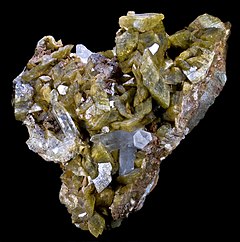Siderite
| Siderite | |
|---|---|

Siderite from Brazil
|
|
| General | |
| Category | Carbonate mineral |
|
Formula (repeating unit) |
FeCO3 |
| Strunz classification | 5.AB.05 |
| Dana classification | 14.01.01.03 |
| Crystal system | Trigonal |
| Crystal class | Hexagonal scalenohedral (3m) H-M symbol: (3 2/m) |
| Space group | R3c |
| Unit cell | a = 4.6916, c = 15.3796 [Å]; Z = 6 |
| Identification | |
| Color | Pale yellow to tannish, grey, brown, green, red, black and sometimes nearly colorless |
| Crystal habit | Tabular crystals, often curved - botryoidal to massive |
| Twinning | Lamellar uncommon on{0112} |
| Cleavage | Perfect on {0111} |
| Fracture | Uneven to conchoidal |
| Tenacity | Brittle |
| Mohs scale hardness | 3.75 - 4.25 |
| Luster | Vitreous, may be silky to pearly |
| Streak | White |
| Diaphaneity | Translucent to subtranslucent |
| Specific gravity | 3.96 |
| Optical properties | Uniaxial (-) |
| Refractive index | nω = 1.875 nε = 1.633 |
| Birefringence | δ = 0.242 |
| Dispersion | Strong |
| References | |
Siderite is a mineral composed of iron(II) carbonate (FeCO3). It takes its name from the Greek word σίδηρος sideros, “iron”. It is a valuable iron mineral, since it is 48% iron and contains no sulfur or phosphorus. Zinc, magnesium and manganese commonly substitute for the iron resulting in the siderite-smithsonite, siderite-magnesite and siderite-rhodochrosite solid solution series.
Siderite has Mohs hardness of 3.75-4.25, a specific gravity of 3.96, a white streak and a vitreous lustre or pearly luster.
It crystallizes in the trigonal crystal system, and are rhombohedral in shape, typically with curved and striated faces. It also occurs in masses. Color ranges from yellow to dark brown or black, the latter being due to the presence of manganese.
Siderite is commonly found in hydrothermal veins, and is associated with barite, fluorite, galena, and others. It is also a common diagenetic mineral in shales and sandstones, where it sometimes forms concretions, which can encase three-dimensionally preserved fossils. In sedimentary rocks, siderite commonly forms at shallow burial depths and its elemental composition is often related to the depositional environment of the enclosing sediments. In addition, a number of recent studies have used the oxygen isotopic composition of sphaerosiderite (a type associated with soils) as a proxy for the isotopic composition of meteoric water shortly after deposition.
...
Wikipedia
